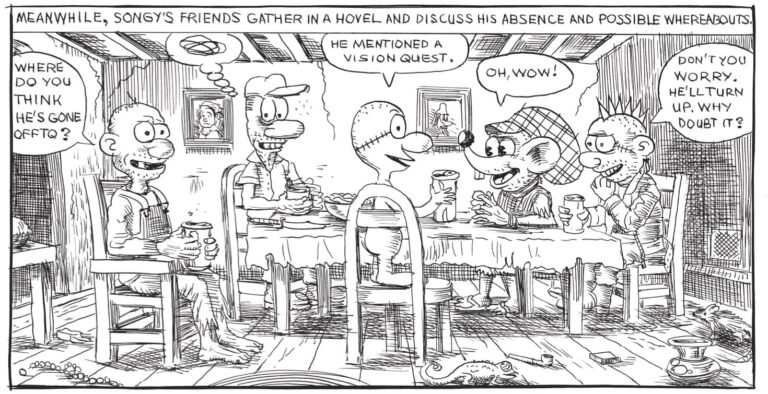Joe McCulloch is here as usual with his indispensable guide to the Week in Comics (spotlight picks this week include new books by Gary Panter and Gou Tanabe), along with a short essay on the latest from Seth:
Ridiculous as it may seem to refer to an artist of Seth's success and renown as underestimated in some sense -- and, actually, I'm of the type who considers success and renown to encourage the use of shorthand to summarize a notable artist's traits, often leading to discreet underestimations -- few have discussed how careful he is in preparing books of unfinished parts so that they read as coherent statements of ideas. He is like Chris Ware in this way, and it's not only a consequence of book design. Clyde Fans: Book One, for example, balances its two Parts as directly opposed in terms of narrative presentation and character motivation. Part One is a veritable one-man show in which Abraham Matchcard, aged air circulation mini-magnate, caught extraordinarily post hoc, walks us through his neighborhood in the then-present of '97, detailing his own life story as a good-not-great salesman while expounding upon local haunts, household knickknacks, and all the things that come to summarize your footprint on this world. Part Two shifts the scene to 1957, finding Abe's timid brother Simon absolutely failing to live up to each and every virtue of his brother's worldview, as just described to us at length. Abe talks directly to the reader; Simon is viewed from omniscience as we follow his disastrous sales tour of bustling Dominion, images from inside his head often interrupting panel sequence, so that his nervous pondering suffuses and frustrates the objective of connecting with customers and the world at large, i.e. customers.
Meanwhile, elsewhere:
—Interviews & Profiles. Maya Barzilai interviews James Sturm about the reprint of his Golem's Mighty Swing.
The golem story resonates with most artists and writers as it is at the core of what we do: creating something and hoping it goes on to have a life of its own.
I encountered the golem story in the pages of the Marvel comics that I read as a kid in the 1970s. In addition to the short-lived “Golem” character from a run of Strange Tales, The Hulk was mistaken for a golem in a 1970 issue. The golem was also one of the few explicitly Jewish characters that I encountered in comics. Later I became aware that almost all of Marvel’s foundational characters have Jewish roots. It’s obvious now, but as a 10-year-old you don’t see it.
Nicholas Eskey talks to Jason Shiga.
I assumed out of the gate that Demon would likely never be published. But instead of trying to make it “more-friendly” to publishers, I wanted to double down and make something even more unpublishable in both form and content. This includes varying issue sizes, from 4 pages to 60 pages, having an all-black issue and of course the depraved content which we’ll talk about later. The plan was that I’d release it as a series of self-printed minicomics over the course of 2 years, then call it a day.
Rob Clough is expanding to include other contributors to his High-Low blog, starting with Whit Taylor, who interviews Miranda Harmon.
But when I sit down and spend time making something with more intent, it can be difficult because I don’t want to hurt anyone with my work. In one journal comic, I show myself explaining to a therapist that I feel, “rotten.” After I made this comic and put it online, a friend who almost never reads any comics at all sat me down and, crying, told me I’m not rotten and that she was worried about me. I was surprised because I nearly forgot that when I put a comic online, it can be read by anyone! I still think that when I make something it’s only for me and a handful of my friends to see, but the reality is different.
New New Yorker cartoon editor Emma Allen talks parenting with cartoonist Emily Flake (video).
The most recent guest on Process Party is Eric Haven.
—Reviews & Commentary. Toni Bentley writes about the mysterious painter and quasi-cartoonist Charlotte Salomon.
In February, 1943, eight months before she was murdered in Auschwitz, the German painter Charlotte Salomon killed her grandfather. Salomon’s grandparents, like many Jews, had fled Germany in the mid-nineteen-thirties, with a stash of “morphine, opium, and Veronal” to use “when their money ran out.” But Salomon’s crime that morning was not a mercy killing to save the old man from the Nazis; this was entirely personal. It was Herr Doktor Lüdwig Grünwald, not “Herr Hitler,” who, Salomon wrote, “symbolized for me the people I had to resist.” And resist she did. She documented the event in real time, in a thirty-five-page letter, most of which has only recently come to light. “I knew where the poison was,” Salomon wrote. “It is acting as I write. Perhaps he is already dead now. Forgive me.” Salomon also describes how she drew a portrait of her grandfather as he expired in front of her, from the “Veronal omelette” she had cooked for him. The ink drawing of a distinguished, wizened man—his head slumped inside the collar of his bathrobe, his eyes closed, his mouth a thin slit nesting inside his voluminous beard—survives.
Mike Lynch remembers the late Martin Landau's short career as a cartoonist.
Martin Landau was a staff cartoonist at the New York Daily News in the 1940s. He was just a kid, assisting other cartoonists (the Daily News' theatrical caricaturist Horace Knight and, later on, THE GUMPS cartoonist Gus Edson). He was seriously thinking that he would maybe be a pro cartoonist one day. Actually, he was; he assisted Edson for several years in the late 1940s, graduating from drawing backgrounds and lettering to drawing THE GUMPS Sunday pages.
Finally, RIP George Romero.
https://www.youtube.com/watch?v=NNIGTSdKPl0






